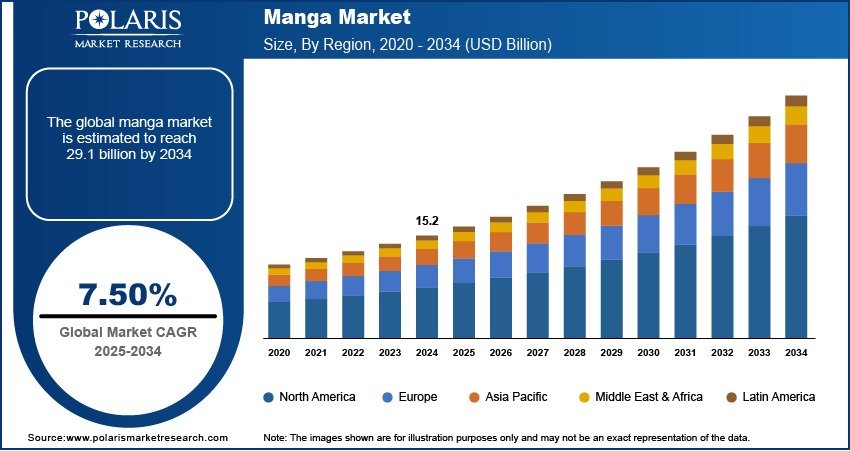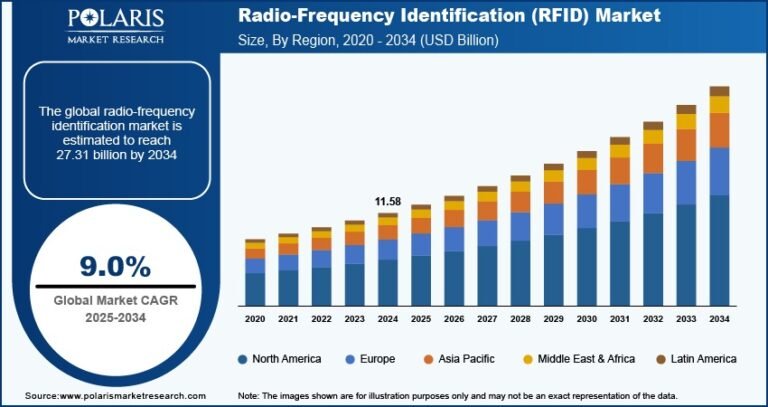Manga Market Size Projected to Reach USD 29.1 Billion by 2034 | Growing at a CAGR of 7.50%

The global Manga Market was valued at USD 15.2 billion in 2024 and is expected to grow at a CAGR of 7.50% from 2025 to 2034. The rise of digital distribution platforms and an expanding international fanbase are major factors driving market growth.
Key Market Trends – Manga Market
- Rising Global Popularity of Japanese Pop Culture
The global appeal of Japanese pop culture, including anime and cosplay, has significantly boosted manga readership beyond Japan. Western countries, especially the U.S., France, and Germany, are seeing surging manga sales, supported by online fan communities and localized translations. - Digital Manga Consumption on the Rise
With the proliferation of smartphones, tablets, and e-readers, digital manga platforms are gaining immense traction. Services like Webtoon, Manga Plus, and other app-based manga readers are making titles more accessible, affordable, and appealing to younger digital-native audiences. - Growing Influence of Anime Adaptations
Successful anime adaptations of popular manga series are driving sales and readership of their source material. Titles like “Demon Slayer,” “Jujutsu Kaisen,” and “Attack on Titan” saw explosive manga sales following anime releases, reinforcing the synergy between both media forms. - Expanding Demographics and Genre Diversity
Manga is increasingly catering to broader audiences across age, gender, and interests. Beyond traditional shonen and shojo genres, there is growing demand for seinen, josei, LGBTQ+ themes, and slice-of-life stories, reflecting evolving reader preferences and inclusivity. - Merchandising and Cross-Media Integration
Manga franchises are extending their reach through video games, films, merchandise, and live-action adaptations. This cross-media strategy enhances brand loyalty and boosts revenue streams, making manga IPs more commercially viable on a global scale. - Subscription Models and Simulpubs Gaining Traction
Subscription-based platforms offering simultaneous global publishing (simulpubs) are transforming how manga is consumed. This trend is helping reduce piracy, ensure legal access, and keep international readers in sync with Japan’s release schedule. - Increased Manga Licensing and Publishing Deals
International publishers are rapidly acquiring manga licenses to meet growing demand. This has led to a boom in translated releases, special editions, and collector’s volumes, particularly in North America and Europe. - Collectible and Luxury Editions Driving Sales
Premium-quality print editions, box sets, and anniversary re-releases are resonating with collectors and nostalgic readers, keeping the print manga segment strong despite the digital shift.
Market Size & Forecast
Market size value in 2025 USD – 16.3 Billion
Revenue forecast in 2034 USD – 29.1 Billion
CAGR – 7.50% from 2025 – 2034
Request for Free Sample:
https://www.polarismarketresearch.com/industry-analysis/manga-market/request-for-sample
Industry Overview:
The manga market refers to the publishing and distribution of Japanese comic books and graphic novels that have gained global popularity across various age groups and demographics. Traditionally published in print, manga has rapidly expanded into digital formats through apps and online platforms, offering greater accessibility to a global audience. The industry is closely linked with anime, gaming, and merchandise, forming a key segment of the broader entertainment and pop culture ecosystem. With a rich storytelling format and diverse genres ranging from action and romance to science fiction and fantasy, manga continues to influence media consumption trends worldwide.
Key Market Drivers & Barriers:
A major driver of the manga market is the growing global fanbase, fueled by the rise of streaming platforms that promote anime adaptations and boost interest in original manga content. Increased availability through digital platforms, subscription services, and translated editions has also broadened reach beyond Japan. Additionally, collaborations between publishers and streaming services, along with rising influencer-driven engagement on social media, are boosting demand. However, challenges such as copyright infringement, piracy, and competition from other forms of entertainment like webtoons and Western comics can hinder growth. High production costs and limited localization efforts in some regions also pose barriers to market expansion.
Market Opportunity:
The manga market presents significant opportunities for growth through further digital transformation, including interactive manga, augmented reality (AR) features, and AI-driven content recommendations. Expansion into emerging markets in Southeast Asia, Latin America, and the Middle East—where youth populations and internet penetration are rising—offers untapped potential. Moreover, the integration of manga into educational and language-learning tools provides new revenue streams. As the global appetite for Japanese pop culture continues to rise, the manga industry is well-positioned to capitalize on evolving consumer preferences and technological advancements.






